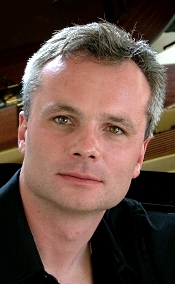 Although Argentine-Israeli pianist and conductor Daniel Barenboim has been playing the piano professionally since the early 1950's, it was really not until the late 1960's that I became aware of his talents, particularly in his admirable recordings of late Mozart symphonies and piano concertos. Since then, the few things I've heard from him have ranged from scintillating to ho-hum. Nor have I ever thought of him as an interpreter or English music. So it was with an open and unsuspecting mind that I listened to this recording of the Elgar First Symphony.
Although Argentine-Israeli pianist and conductor Daniel Barenboim has been playing the piano professionally since the early 1950's, it was really not until the late 1960's that I became aware of his talents, particularly in his admirable recordings of late Mozart symphonies and piano concertos. Since then, the few things I've heard from him have ranged from scintillating to ho-hum. Nor have I ever thought of him as an interpreter or English music. So it was with an open and unsuspecting mind that I listened to this recording of the Elgar First Symphony.Now, what you have to understand is that Elgar hardly fit the mold of the English pastoral composers of his day. Elgar was much more extrovert than that, wherein lies the dilemma for a conductor. Does one conduct Elgar all-out for glitzy excitement, or does one show more restraint and rein in some of the pageantry and thrills? Certainly, there is enough of everything in Elgar's music to satisfy any conductor's ambitions, yet even though Barenboim sometimes goes all out, I kept wondering if a bit more passionate reserve wasn't in order.
Who knows? Maybe I'm just too used to older, more conventional readings of the First Symphony by conductors like Sir Adrian Boult and the London Philharmonic (EMI) and Sir John Barbirolli and the Philharmonia Orchestra (EMI); or the more volatile rendering by Sir Georg Solti with the London Philharmonic (Decca). Then, too, there are later recordings to consider from Richard Hickox, Vernon Handley, Mark Elder, and Vasily Petrenko, among others. There is a lot of competition out there for Baremboim to deal with, and a variety of interpretive angles for the listener to explore.
Anyway, Sir Edward Elgar (1857-1934) was one of England's most-important and most-famous composers. He wrote his Symphony No. 1 in A flat, Op. 55, in 1908, just a few years after he completed the first four of his Pomp and Circumstance Marches, apparently thinking he had plenty of pomp and circumstance left over for the symphony. In describing the music, Elgar said "There is no programme beyond a wide experience of human life with a great charity (love) and a massive hope in the future." So, yes, it is an optimistic work, full of noble ambition.
 |
| Daniel Barenboim |
For a symphony that boasts a strong internal unity, under Barenboim it sounds slightly disjointed, a string of ups and downs without a center. Whatever, the second-movement Allegro, which acts as a scherzo, shows the conductor at his most energetic, which, if anything, may be a little too exuberant for the lovely tunes the faster parts encompass.
The third-movement Adagio is similar to the preceding music but at a slower pace, returning us to the unhurried mood of the beginning, with Barenboim producing some lovely moments of quiet, deeply felt solitude and serenity. For me, this was the conductor's strongest section.
Then, the closing Lento-Allegro returns to Elgar's alternating slow-fast-slow-fast design. It recaps the first movement, starting slowly and building to one of the grandest displays of orchestral exposition one could imagine. Unfortunately, Barenboim seems to think that sheer excitement can substitute for genuine human attachment. Again, I found myself admiring the conductor's strict interpretation of the score while never hearing much that grabbed my attention and held it.
Oddly, with only about fifty minutes of music on the disc, Decca offer no coupling, no fill-up. Not that it matters, as most people will probably only want the symphony, but there is a good half hour-plus left unused on the CD, and most rival discs provide one or two shorter Elgar works as pairings.
Producer Andrew Keener and engineer Sebastian Nattkemper recorded the album at the Philharmonie, Berlin in September 2015. The sound is clear and natural, smooth and well balanced. It places easily among the best work Decca engineers have done. Big crescendos come across with ease, with a wide dynamic range and plenty of impact. Ultimate transparency is bit lacking, but the realism is evident in every note. There is also a good stage width, at least a modicum of depth, and a solid, satisfying bass response.
JJP
To listen to a brief excerpt from this album, click on the forward arrow:





















